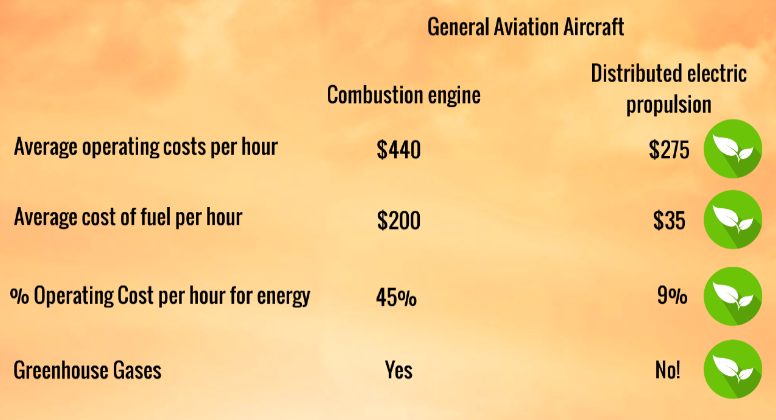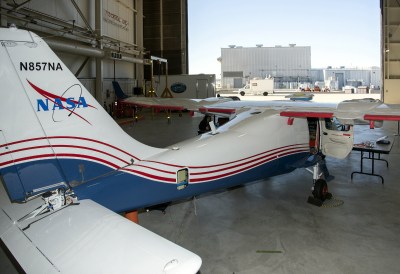NASA Readies New Electric X-Plane For First Flight
Since 1951, NASA (known in those pre-space days as NACA) and the United States Air Force have used the “X” designation for experimental aircraft that push technological boundaries. The best known of these vehicles, such as the X-1 and X-15, were used to study flight at extreme altitude and speed. Several fighter jets got their start as X-planes over the decades, and a number of hypersonic scramjet vehicles have flown under the banner. As such, the X-planes are often thought of as the epitome of speed and maneuverability.
So the X-57 Maxwell, NASA’s first piloted X-plane in two decades, might seem like something of a departure from the blistering performance of its predecessors. It’s not going to fly very fast, it won’t be making any high-G turns, and it certainly won’t be clawing its way through the upper atmosphere. The crew’s flight gear won’t even be anything more exotic than a polo and a pair of shorts. As far as cutting-edge experimental aircraft go, the X-57 is about as laid back as it gets.
But like previous X-planes, the Maxwell will one day be looked back on as a technological milestone of its own. Just as the X-1 helped usher in the era of supersonic flight, the X-57 has been developed so engineers can better understand the unique challenges of piloted electric aircraft. Before they can operate in the public airspace, the performance characteristics and limitations of electric planes must be explored in real-world scenarios. The experiments performed with the X-57 will help guide certification programs and government rule making that needs to be in place before such aircraft can operate on a large scale.
The Case for Electric Flight
To be clear, the commercial jetliner is in no danger of being replaced by an all-electric aircraft anytime soon. It would take a considerable breakthrough in energy storage, perhaps based on a whole new battery chemistry, to make such a plane viable even for domestic flights. It will be exceedingly difficult for electric motors to compete against modern turbofan engines, which have themselves seen a number of improvements over the decades to maximize power and fuel efficiency.

But that doesn’t mean there aren’t niches that electric aircraft could fill. Short flights with rapid turnaround times would be ideal for an electrically driven plane, especially if battery packs could be quickly swapped out upon landing.
If the packs can be charged via on-site renewable sources like wind or solar, it would even be possible to perform these flights with zero emissions. This would represent a considerable improvement over the relatively inefficient internal combustion engines which are generally used on the small aircraft that perform these short “hops” today.
Even if we ignore the potential environmental impact of using electric motors on aircraft, there are other compelling advantages. An electric plane will be quieter than its piston or turbine driven peers, and will be much less complex to maintain and operate safely. They would be particularly attractive to private owners, as they should be far cheaper to fly than traditionally powered aircraft.
Divide and Conquer
Unlike the more daring X-planes of the past, the X-57 actually got its start as a commercially available aircraft. Specifically a twin-engine Tecnam P2006T, which is notable for being one of the lightest weight planes in its class. Even when you factor in the cost of the modifications NASA has made, the sticker price of slightly less than $500,000 USD for a stock P2006T likely makes this one of the least expensive vehicles to ever carry an X designation.
As NASA sees electric aircraft as being well suited for so-called “General Aviation” flights, it makes sense they would want to base their experimental craft on an existing design that serves this market. Why go through the time and expense of developing a whole new aircraft when all you really want to test is the propulsion system?
To that end, NASA has replaced the original wing and engines of the Tecnam P2006T with what they are calling a “Distributed Electric Propulsion” system. Owing to the fact that the electric motors are less powerful than the original combustion engines they are replacing, it takes fourteen of them to propel the X-57 during takeoff and landing. But once the plane is in the air and at cruising altitude, the twelve motors in the center will shut down to save energy.

The center motors will use folding centrifugal propellers, so that once they are no longer rotating, they will lay flat against their nacelles to reduce drag. When additional power is needed, they will extend as the motors are spun back up. This arrangement is far less complex than the feathering mechanism traditionally used in multi-engine aircraft, and has the added benefit of being completely automatic. As long as the joints are regularly lubricated, physics can be relied on to take care of the rest.
When active, these small motors will dramatically increase the amount of airflow over the wing, which in turn increases lift. This boosted performance has allowed NASA to greatly slim down the plane’s wings, while the relatively low weight of the large electric motors allowed them to be placed at the wingtips. With all of these elements are combined, the X-57 is unlike anything that’s ever flown before.
Some Assembly Required

There’s still quite a bit of work to be done before the X-57 takes to the air under all fourteen electric motors. Presently, the project is at the “Mod II” stage, which is where the original Rotax 912S3 engines have been replaced with the same motors that will eventually be relocated to the tips of the new wing. The wing itself has recently completed its structural testing, and once it has been installed on the X-57 aircraft, the program will officially be in its third stage.
The final stage, “Mod IV”, will see the installation of the twelve smaller motors along the leading edge of the newly installed wing. At each stage it’s expected the efficiency of the aircraft will be increased, and ultimately NASA hopes to demonstrate a five-fold reduction in the energy necessary to operate this type of light aircraft. While the agency’s response to COVID-19 has slowed or halted several major projects, NASA says work on the X-57 Maxwell is continuing in California, and that flight tests with the plane in its final configuration are still expected before the end of the year.
from Hackaday https://ift.tt/2KIO6II
Comments
Post a Comment